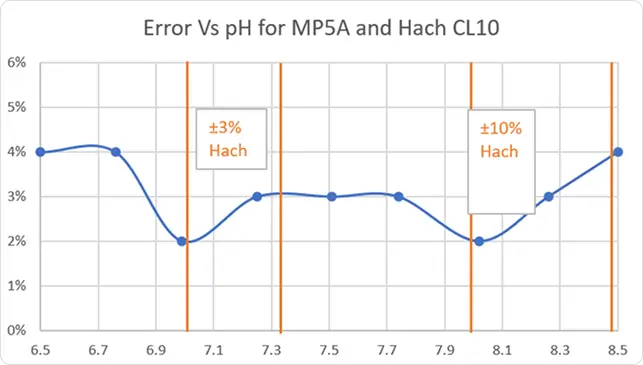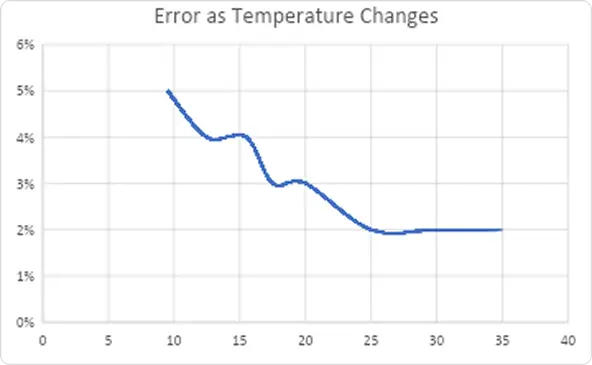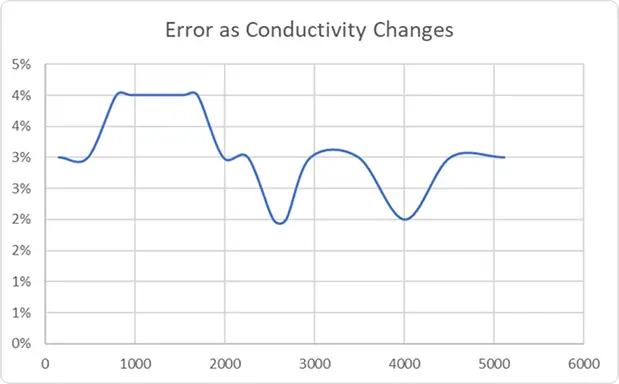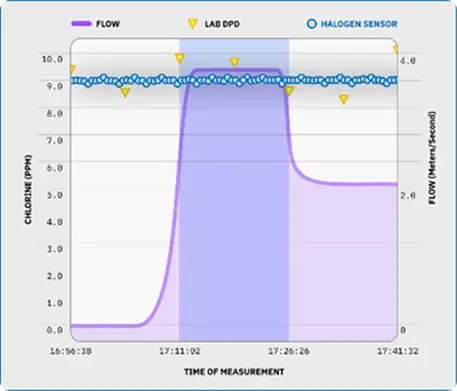White Paper MP5-A new standard in accuracy
- Home
- White Paper MP5-A new standard in accuracy
The new MP5-A: a dramatic improvement in accuracy
The New MP5-A is now more accurate over a wide range of pH, conductivity, and temperature. This means more stable calibration of six months or more is possible. Chlorine sensor specifications often have no relationship to the real world. The conditions in which published specifications were taken are often not disclosed. (Australia, 2010) Furthermore, conditions like pH and temperature are held constant during the specification test. This almost never happens in the real world of a treatment plant. Frequent calibrations waste labor resources and increase a sensor’s operating costs and can be opaque to operators and management. A wider operating range will save plant resources and provide a more consistent product.
The MP5-A is the latest version of our Multiparameter sensor for drinking water applications and has undergone dramatic improvements. This sensor measures five parameters critical for water quality. For our test we calibrated the MP5-A at one set of conditions,* then changed the conditions seen in the below graphs.
Other manufacturers measure accuracy at one or two sets of conditions. An example is Hach’s CL10f specification for chlorine accuracy: First condition: Free Chlorine: ±3% of the reference test** (DPD) at constant pH less than 7.2 (±0.2 pH unit) ±10% of the reference test.** (Hach, 2023) Second condition: Free Chlorine: ± 10 % of the reference test** (DPD) at stable pH less than 8.5 (±0.5 pH unit from the pH at calibration). While this spec looks respectable, compare it to the performance of Halogen’s MP5-A :
Hach calibrated separately at two pH ranges 7.2 and 8.5. For this test, the MP5-A was calibrated once at a single condition: pH 8.0 and the pH was changed from 6.5 to 8.5. The chlorine accuracy stayed within ±4% of the reference test. Halogen is accurate over a much wider pH range than Hach (or in fact, any other chlorine sensor).


Error Vs pH for MP5A and Hach Cl10
Hach does not mention temperature. MP5 is also accurate over a temperature of 10 to 35°C, also within ±5% of the reference test. *
Note:- In this test, we calibrated 9 sensors at pH 8.0 and chlorine level of 1.25 ppm at 2,700 µS and 20°C. Then we varied the pH, then the conductivity and finally the temperature. Accuracy varied by only ±4% or less.
Error as Temperature Changes
Hach does not mention conductivity changes: we varied the conductivity from 156 to 10,000 µS and the chlorine reading varied by only ±4%.

This means that as your water chemistry variables change, your MP5A sensor calibration will not change, hence not require recalibration due to changing conditions saving many labor hours.
This also means that the MP5 can be factory calibrated and will often be accurate when installed without the need for initial calibration.
Ultra Low Chlorine Readings
Hach does not mention conductivity changes: we varied the conductivity from 156 to 10,000 µS and the chlorine reading varied by only ±4%.
In addition, the MP5 can operate at zero ppm for hours and when increased, it will read very low levels of chlorine. No membrane sensor can do this. Membrane sensors also require some flow to measure accurately (Analytical Technology Inc., 2018). MP5 does not require this, which means it works well in immersion applications in tanks.

Remote Applications
Halogen has stable calibration under changing variables but also under flow changes. This makes possible direct pipe insertion of the sensor. Distribution system monitoring is now practical, giving utilities insight into what is happening after the water leaves the plant. Dead end monitoring can indicate the need for flushing and provide better water quality for consumers. The below graph shows that as the flow is varied from zero to 60 gpm, then 120 gpm. There was virtually no change in signal. (HSI Flow Rpt, 2019).
Bibliography
Analytical Technology Inc. (2018, August).
https://www.analyticaltechnology.com/sys/manuals/1198/A22-79%20Total%20Chlorine%20Chlorlog.pdf. Retrieved from Analytical Technology Inc.
Australia, W. Q. (2010). Development of Tools for Improved Disinfection Control within Distribution Systems. WQRA.
Hach. (2023, 11 22). Hach CL10 Specifications. Retrieved from
www.Hach.com: https://www.hach.com/p-cl10sc-amperometric-chlorine-analyzers/LXV45A.99.13022#specifications
The new MP5-A: a dramatic improvement in accuracy
The New MP5-A is now more accurate over a wide range of pH, conductivity, and temperature. This means more stable calibration of six months or more is possible. Chlorine sensor specifications often have no relationship to the real world. The conditions in which published specifications were taken are often not disclosed. (Australia, 2010) Furthermore, conditions like pH and temperature are held constant during the specification test. This almost never happens in the real world of a treatment plant. Frequent calibrations waste labor resources and increase a sensor’s operating costs and can be opaque to operators and management. A wider operating range will save plant resources and provide a more consistent product.
The MP5-A is the latest version of our Multiparameter sensor for drinking water applications and has undergone dramatic improvements. This sensor measures five parameters critical for water quality. For our test we calibrated the MP5-A at one set of conditions,* then changed the conditions seen in the below graphs.
Other manufacturers measure accuracy at one or two sets of conditions. An example is Hach’s CL10f specification for chlorine accuracy: First condition: Free Chlorine: ±3% of the reference test** (DPD) at constant pH less than 7.2 (±0.2 pH unit) ±10% of the reference test.** (Hach, 2023) Second condition: Free Chlorine: ± 10 % of the reference test** (DPD) at stable pH less than 8.5 (±0.5 pH unit from the pH at calibration). While this spec looks respectable, compare it to the performance of Halogen’s MP5-A :
Hach calibrated separately at two pH ranges 7.2 and 8.5. For this test, the MP5-A was calibrated once at a single condition: pH 8.0 and the pH was changed from 6.5 to 8.5. The chlorine accuracy stayed within ±4% of the reference test. Halogen is accurate over a much wider pH range than Hach (or in fact, any other chlorine sensor).


Error Vs pH for MP5A and Hach Cl10
Hach does not mention temperature. MP5 is also accurate over a temperature of 10 to 35°C, also within ±5% of the reference test. *
Note:- In this test, we calibrated 9 sensors at pH 8.0 and chlorine level of 1.25 ppm at 2,700 µS and 20°C. Then we varied the pH, then the conductivity and finally the temperature. Accuracy varied by only ±4% or less.
Error as Temperature Changes
Hach does not mention conductivity changes: we varied the conductivity from 156 to 10,000 µS and the chlorine reading varied by only ±4%.

This means that as your water chemistry variables change, your MP5A sensor calibration will not change, hence not require recalibration due to changing conditions saving many labor hours.
This also means that the MP5 can be factory calibrated and will often be accurate when installed without the need for initial calibration.
Ultra Low Chlorine Readings
Hach does not mention conductivity changes: we varied the conductivity from 156 to 10,000 µS and the chlorine reading varied by only ±4%.
In addition, the MP5 can operate at zero ppm for hours and when increased, it will read very low levels of chlorine. No membrane sensor can do this. Membrane sensors also require some flow to measure accurately (Analytical Technology Inc., 2018). MP5 does not require this, which means it works well in immersion applications in tanks.

Remote Applications
Halogen has stable calibration under changing variables but also under flow changes. This makes possible direct pipe insertion of the sensor. Distribution system monitoring is now practical, giving utilities insight into what is happening after the water leaves the plant. Dead end monitoring can indicate the need for flushing and provide better water quality for consumers. The below graph shows that as the flow is varied from zero to 60 gpm, then 120 gpm. There was virtually no change in signal. (HSI Flow Rpt, 2019).
Bibliography
Analytical Technology Inc. (2018, August).
https://www.analyticaltechnology.com/sys/manuals/1198/A22-79%20Total%20Chlorine%20Chlorlog.pdf. Retrieved from Analytical Technology Inc.
Australia, W. Q. (2010). Development of Tools for Improved Disinfection Control within Distribution Systems. WQRA.
Hach. (2023, 11 22). Hach CL10 Specifications. Retrieved from
www.Hach.com: https://www.hach.com/p-cl10sc-amperometric-chlorine-analyzers/LXV45A.99.13022#specifications